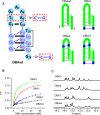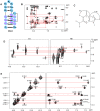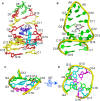Structure-guided post-SELEX optimization of an ochratoxin A aptamer
- PMID: 31062016
- PMCID: PMC6582339
- DOI: 10.1093/nar/gkz336
Structure-guided post-SELEX optimization of an ochratoxin A aptamer
Abstract
SELEX is the cornerstone for aptamer research with broad applications in biosensors and medicine. To improve the affinity of selected aptamers, we propose a structure-guided post-SELEX approach, an optimization method based on the precise secondary structure of the aptamer-ligand complex. We demonstrate this approach using the Ochratoxin A (OTA) aptamer. Guided by the structure, we designed a new aptamer whose affinity is improved by more than 50-fold. We also determined the high-resolution NMR structure of the new aptamer-OTA complex and elucidated the discriminatory recognition mechanism of one atomic difference between two analogs, OTA and OTB. The aptamer forms an unusual hairpin structure containing an intramolecular triple helix, which is not seen in the previously determined aptamer complex. The π-π stacking, the hydrophobic interaction, hydrogen bonds and halogen bonds between OTA and the aptamer contribute to the recognition of OTA, and the halogen bonds play an important role in discriminating between OTA and OTB. Our results demonstrate that the structure-guided post-SELEX approach improves aptamers affinity. An improved OTA biosensor system might be developed using this new strategy.
© The Author(s) 2019. Published by Oxford University Press on behalf of Nucleic Acids Research.
Figures






Similar articles
-
Structural Insights into the Mechanism of High-Affinity Binding of Ochratoxin A by a DNA Aptamer.J Am Chem Soc. 2022 May 4;144(17):7731-7740. doi: 10.1021/jacs.2c00478. Epub 2022 Apr 20. J Am Chem Soc. 2022. PMID: 35442665
-
Titanium Dioxide Nanoparticles (TiO₂) Quenching Based Aptasensing Platform: Application to Ochratoxin A Detection.Toxins (Basel). 2015 Sep 22;7(9):3771-84. doi: 10.3390/toxins7093771. Toxins (Basel). 2015. PMID: 26402704 Free PMC article.
-
Detachable nanoladders: A new method for signal identification and their application in the detection of ochratoxin A (OTA).Anal Chim Acta. 2019 Dec 9;1087:113-120. doi: 10.1016/j.aca.2019.08.057. Epub 2019 Aug 27. Anal Chim Acta. 2019. PMID: 31585559
-
Aptamers as molecular recognition elements in chromatographic separations.Adv Chromatogr. 2007;45:173-96. doi: 10.1201/9781420018066.ch4. Adv Chromatogr. 2007. PMID: 17626559 Review. No abstract available.
-
Improving aptamer performance: key factors and strategies.Mikrochim Acta. 2023 Jun 10;190(7):255. doi: 10.1007/s00604-023-05836-6. Mikrochim Acta. 2023. PMID: 37300603 Review.
Cited by
-
Optimization of Surface-Enhanced Raman Spectroscopy Detection Conditions for Interaction between Gonyautoxin and Its Aptamer.Toxins (Basel). 2022 Jan 11;14(1):49. doi: 10.3390/toxins14010049. Toxins (Basel). 2022. PMID: 35051026 Free PMC article.
-
Comparative Study of Single-stranded Oligonucleotides Secondary Structure Prediction Tools.BMC Bioinformatics. 2023 Nov 8;24(1):422. doi: 10.1186/s12859-023-05532-5. BMC Bioinformatics. 2023. PMID: 37940855 Free PMC article.
-
Blocker-SELEX: a structure-guided strategy for developing inhibitory aptamers disrupting undruggable transcription factor interactions.Nat Commun. 2024 Aug 8;15(1):6751. doi: 10.1038/s41467-024-51197-w. Nat Commun. 2024. PMID: 39117705 Free PMC article.
-
Engineered aptamers for molecular imaging.Chem Sci. 2023 Nov 21;14(48):14039-14061. doi: 10.1039/d3sc03989g. eCollection 2023 Dec 13. Chem Sci. 2023. PMID: 38098720 Free PMC article. Review.
-
Chemically modified aptamers for improving binding affinity to the target proteins via enhanced non-covalent bonding.Front Cell Dev Biol. 2023 Feb 23;11:1091809. doi: 10.3389/fcell.2023.1091809. eCollection 2023. Front Cell Dev Biol. 2023. PMID: 36910146 Free PMC article. Review.
References
-
- Tuerk C., Gold L.. Systematic evolution of ligands by exponential enrichment: RNA ligands to bacteriophage T4 DNA polymerase. Science. 1990; 249:505–510. - PubMed
-
- Ellington A.D., Szostak J.W.. In vitro selection of RNA molecules that bind specific ligands. Nature. 1990; 346:818–822. - PubMed
-
- Verdian A. Apta-nanosensors for detection and quantitative determination of acetamiprid - a pesticide residue in food and environment. Talanta. 2018; 176:456–464. - PubMed
-
- Syed M.A., Jamil B.. Aptamers and aptasensors as novel approach for microbial detection and identification: an appraisal. Curr. Drug Targets. 2018; 19:1560–1572. - PubMed
Publication types
MeSH terms
Substances
LinkOut - more resources
Full Text Sources
Other Literature Sources
Research Materials
Miscellaneous

